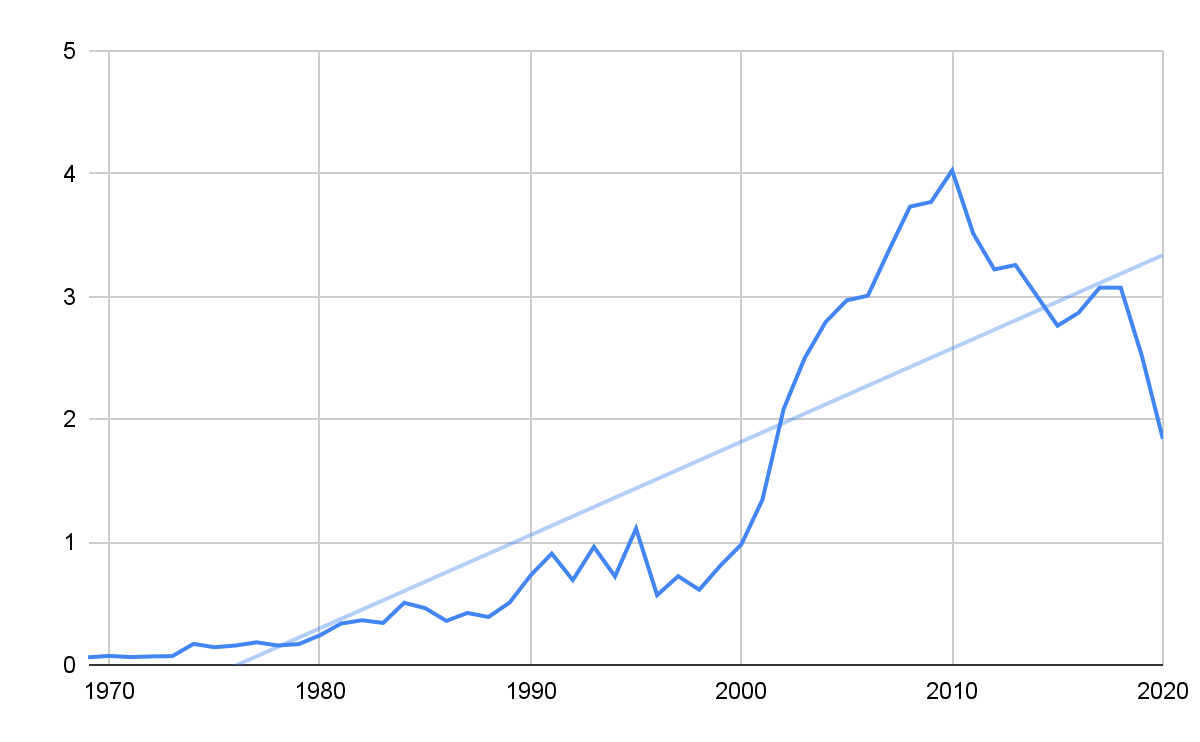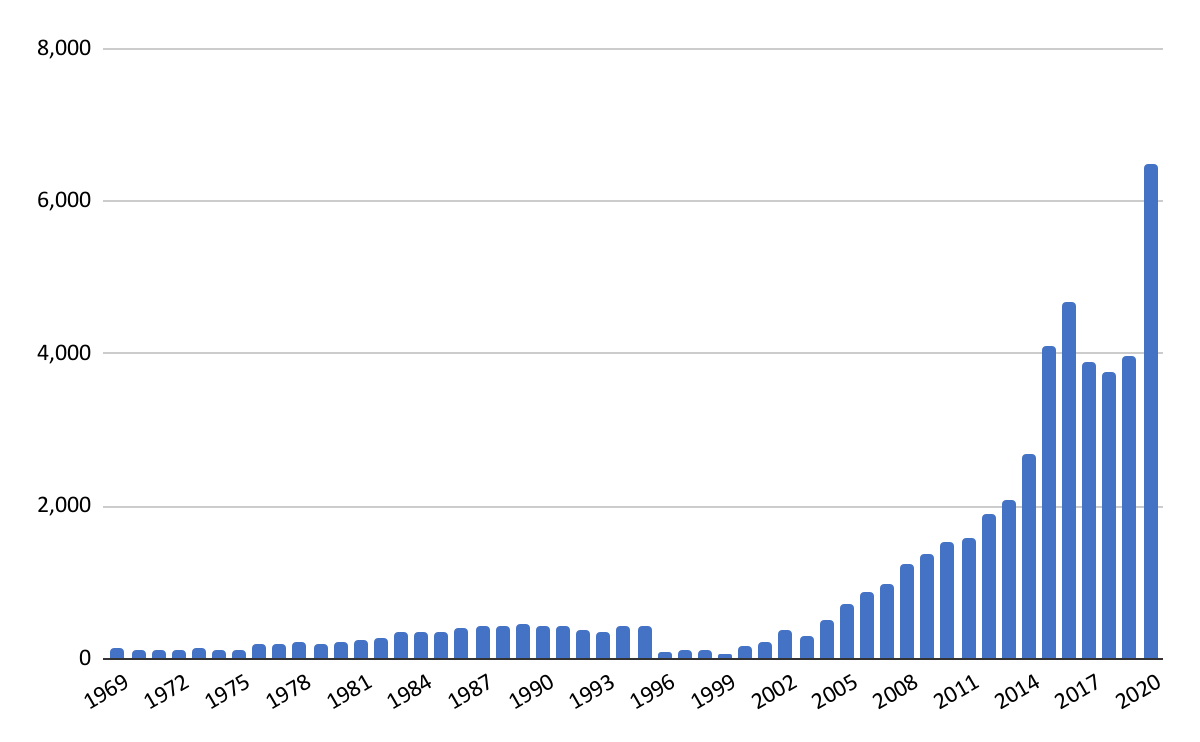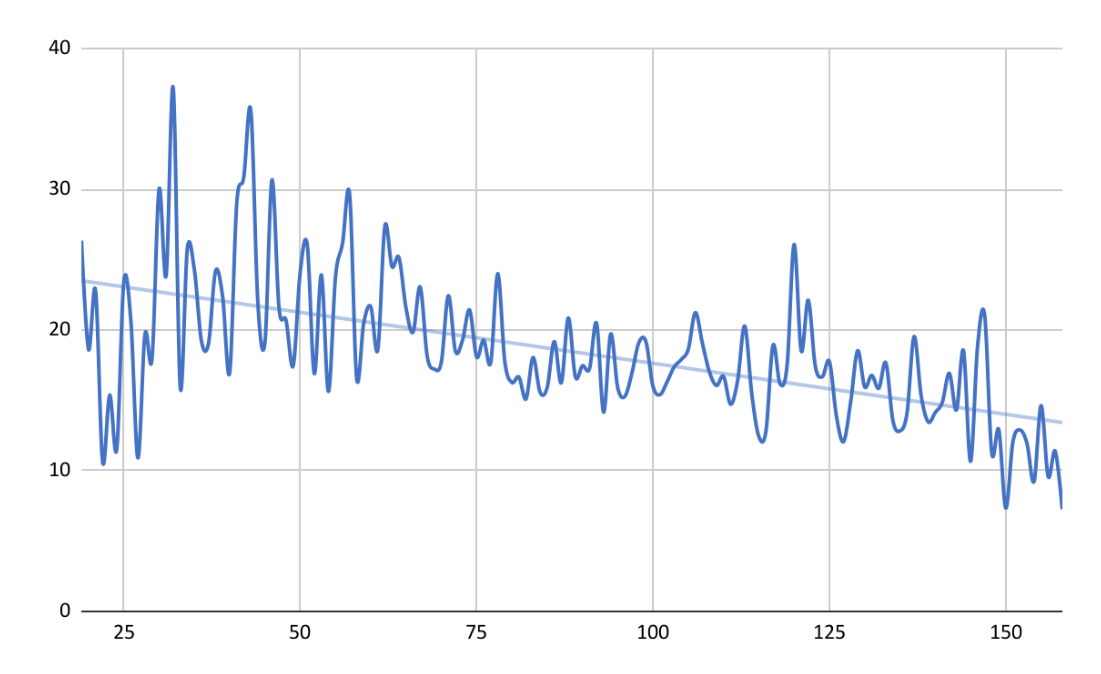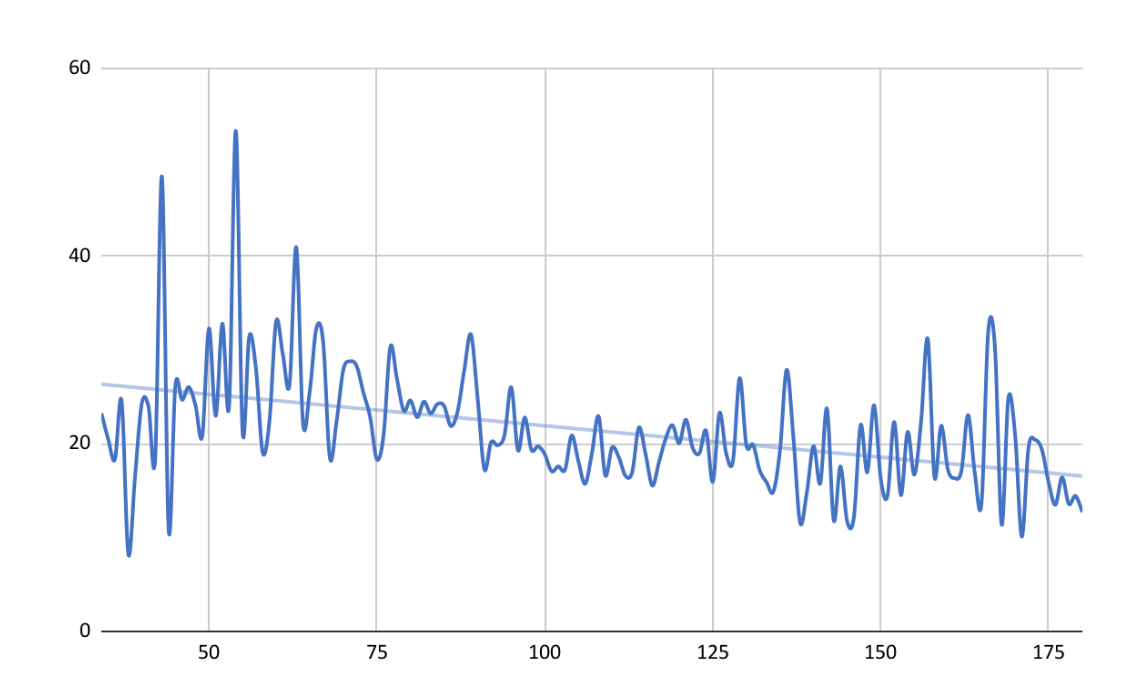A 50-Year Analysis of Education Research Article Feature Effects on Citation Counts
By analyzing 50 years of citation counts of 51,281 research articles across 86 education journals in conjunction with textual analysis of article titles and abstracts, we explore how a variety of article features, such as title length, use of a subtitle, reading difficulty, and open access status, have historically influenced the impact of education research articles. Results indicate that (a) shorter titles are more likely to be cited than long titles, (b) articles with subtitles (designated with a colon) are more likely to be cited, (c) articles with lengthy and more technical abstracts are more likely to be cited, and (d) open access status has no effect.
The guiding research question of this analysis was “What is the relationship between education research article features and citation counts?” Central to our asking this question is the notion that citation count as a measure of impact may be influenced by a variety of factors that may have little to do with a given study’s scientific or professional merit or that subtle decisions regarding an article’s title or abstract might influence its citability. To answer this question, we utilized hierarchical linear modeling (HLM) to analyze Scopus database metrics for top education research journals to determine the strengths of relationships between two independent citation variables, six independent article feature variables, and two covariates. In total, 51,281 articles from 86 journals were analyzed, inclusively representing the years 1969 to 2020 (see Table 1).
Table 1
List of Journals with Number of Articles and Year Ranges
| Journal Title | Number of Articles | Year Range |
|---|
| Minimum | Maximum |
|---|
| Assessment & Evaluation in Higher Education | 470 | 1981 | 2020 |
| Australasian Journal of Educational Technology | 783 | 2008 | 2020 |
| Australian Journal of Teacher Education | 357 | 2009 | 2014 |
| British Journal of Educational Psychology | 496 | 1969 | 2020 |
| British Journal of Educational Technology | 1,892 | 1973 | 2020 |
| Cogent Education | 744 | 2014 | 2020 |
| Community College Journal of Research and Practice | 345 | 1993 | 2020 |
| Computer Assisted Language Learning | 641 | 1990 | 2020 |
| Computers & Education | 3,204 | 1986 | 2020 |
| Contemporary Educational Psychology | 318 | 1980 | 2020 |
| Counselor Education and Supervision | 295 | 1969 | 2020 |
| Education and Information Technologies | 1,303 | 2000 | 2020 |
| Education and Urban Society | 306 | 1973 | 2020 |
| Educational Administration Quarterly | 553 | 1969 | 2020 |
| Educational Assessment, Evaluation and Accountability | 121 | 2013 | 2020 |
| Educational Management Administration & Leadership | 645 | 1974 | 2020 |
| Educational Policy | 399 | 1987 | 2020 |
| Educational Psychologist | 297 | 1970 | 2020 |
| Educational Psychology | 521 | 1981 | 2020 |
| Educational Psychology Review | 230 | 1990 | 2020 |
| Educational Technology & Society | 1,535 | 2000 | 2020 |
| Educational Technology Research and Development | 932 | 1993 | 2020 |
| English Language Teaching | 733 | 2012 | 2015 |
| English Language Teaching Journal | 1,060 | 1973 | 2020 |
| European Journal of Teacher Education | 861 | 1982 | 2020 |
| Higher Education | 446 | 1976 | 2020 |
| Higher Education Research & Development | 516 | 1982 | 2020 |
| IEEE Transactions on Learning Technologies | 458 | 2008 | 2020 |
| Improving Schools | 182 | 1998 | 2020 |
| Innovations in Education and Teaching International | 223 | 2015 | 2020 |
| Innovative Higher Education | 99 | 1996 | 2020 |
| Interactive Learning Environments | 1,043 | 1990 | 2020 |
| International Journal of Artificial Intelligence in Education | 283 | 2000 | 2020 |
| International Journal of Doctoral Studies | 63 | 2014 | 2020 |
| International Journal of Educational Management | 755 | 1987 | 2020 |
| International Journal of Instruction | 911 | 2013 | 2020 |
| International Journal of Leadership in Education | 344 | 2003 | 2020 |
| Internet and Higher Education | 540 | 2001 | 2020 |
| Journal of College Student Development | 142 | 2004 | 2020 |
| Journal of College Student Retention: Research, Theory, & Practice | 148 | 2010 | 2020 |
| Journal of Computer Assisted Learning | 953 | 1985 | 2020 |
| Journal of Counseling & Development | 415 | 1985 | 2020 |
| Journal of Counseling Psychology | 715 | 1975 | 2019 |
| Journal of Diversity in Higher Education | 129 | 2014 | 2020 |
| Journal of Education Policy | 421 | 1986 | 2020 |
| Journal of Educational Administration | 615 | 1969 | 2020 |
| Journal of Educational Computing Research | 490 | 2011 | 2020 |
| Journal of Educational Psychology | 497 | 1974 | 2020 |
| Journal of Educational Research | 1,864 | 1969 | 2020 |
| Journal of Further and Higher Education | 334 | 1977 | 2020 |
| Journal of Higher Education Policy and Management | 140 | 2009 | 2020 |
| Journal of International Students | 177 | 2015 | 2020 |
| Journal of Mathematics Teacher Education | 401 | 2005 | 2020 |
| Journal of Psychoeducational Assessment | 741 | 1983 | 2020 |
| Journal of School Choice | 203 | 2006 | 2020 |
| Journal of School Psychology | 213 | 1982 | 2020 |
| Journal of Science Teacher Education | 630 | 1989 | 2020 |
| Journal of Studies in International Education | 82 | 2004 | 2020 |
| Journal of Teacher Education | 908 | 1969 | 2020 |
| Language Learning & Technology | 361 | 2000 | 2020 |
| Leadership and Policy in Schools | 243 | 2014 | 2020 |
| Learning and Individual Differences | 751 | 2013 | 2020 |
| Learning Disability Quarterly | 252 | 1978 | 2020 |
| Learning, Media and Technology | 415 | 2005 | 2020 |
| Management in Education | 231 | 1987 | 2020 |
| Phi Delta Kappan | 695 | 1996 | 2020 |
| Professional Development in Education | 634 | 2009 | 2020 |
| Psychology in the schools | 736 | 1975 | 2020 |
| Research in Higher Education | 141 | 1974 | 2020 |
| School Effectiveness and School Improvement | 232 | 1990 | 2020 |
| School Leadership & Management | 190 | 2002 | 2020 |
| School Psychology International | 621 | 1979 | 2020 |
| School Psychology Quarterly | 55 | 2019 | 2020 |
| Social Psychology of Education | 306 | 2001 | 2020 |
| Studies in Higher Education | 736 | 1976 | 2020 |
| Teachers and Teaching | 793 | 1995 | 2020 |
| Teaching and Teacher Education | 2,484 | 1985 | 2020 |
| Teaching in Higher Education | 1,036 | 2005 | 2020 |
| Technology, Pedagogy and Education | 468 | 2003 | 2020 |
| TechTrends | 431 | 2000 | 2020 |
| TESOL Quarterly | 877 | 1981 | 2020 |
| The International Review of Research in Open and Distributed Learning | 1,054 | 2000 | 2020 |
| The Journal of Higher Education | 81 | 2015 | 2020 |
| The Review of Higher Education | 50 | 2015 | 2020 |
| The Turkish Online Journal of Educational Technology | 1,643 | 2008 | 2017 |
| Theory Into Practice | 643 | 1980 | 2020 |
Our independent citation variables consisted of two variations of the citation count metric provided by Scopus: (a) raw citations and (b) citations per year. Raw citations represented the total number of times that an article had been cited in its entire lifespan. As one might expect, these counts were somewhat influenced by publication date because it takes time for articles to be read and cited in subsequent publications, meaning that articles published earlier in a given year might exhibit a citation advantage over articles published later in the same year (see Figure 1). For this reason, we also recoded raw citation counts as citations per year by multiplying the citation count by 365 and dividing this value by the number of days that had elapsed since the article had been published (see Figure 2). This recoding helped control for elapsed time but also revealed a general positive relationship between year published and citations per year, suggesting that more recent articles were being cited at a higher rate than their predecessors. Uncertain of which of these two metrics would be the most reliable for accounting for complexities of time, we constructed separate models for each to see if results converged to tell a similar story.
Figure 1
Average Article Raw Citations by Year Published (R2 = 0.28)

Figure 2
Average Article Citations per Year by Year Published (R2 = 0.78)

Independent article features included the following six variables:
- Title Character Count: The number of characters (i.e., numbers, letters, or punctuation) in the article’s title (see Table 2 for descriptives).
- Title Colon: Whether the title included a colon, thereby suggesting the presence of a subtitle (0 = no colon [n = 27,921] and 1 = colon present [n = 23,336]).
- Abstract Reading Difficulty: The Flesch-Kincaid Reading Ease score for the article’s abstract (0 = very difficult to read and 100 = very easy to read; see Table 2 for descriptives).
- Abstract Reading Time: The predicted number of seconds needed for the average adult to read the abstract as calculated on a range from 150 words per minute for a Reading Ease score of 0 to 300 words per minute for a score of 100 (see Table 2 for descriptives).
- Abstract Word Count: The number of words in the abstract (see Table 2 for descriptives).
- Open Access: Whether the article was marked as released under an open access agreement (0 = non-open access [n = 44,663] and 1 = open access [n = 6,618]).
Table 2
Descriptives of Continuous Variables
| |
Mean |
SD |
Min |
Max |
| Title Character Count |
92.107 |
30.990 |
6 |
255 |
| Abstract Reading Ease |
24.349 |
13.551 |
0 |
100 |
| Abstract Reading Speed |
52.755 |
20.434 |
1 |
459 |
| Abstract Word Count |
161.918 |
60.874 |
4 |
1,289 |
A year covariate was also included to better control for time-based effects on citation counts. Annual totals of articles revealed a general upward trend in article volume with a few notable exceptions between 1996 and 2003 (see Figure 3). The increase in article volume overall was likely due to more journals releasing online versions over time since the early 2000s (and thereby increasing the number of articles that could be published without the cost prohibitions of a paper-based medium), but it was unclear to us why a dip occurred in 1996. Nonetheless, we did not expect these variations in volume to impact results in a meaningful way but used year as a covariate to ensure that historical or other anomalies in the data would be accounted for. Furthermore, our models were constructed using M+ software, which preferred for these values to be normalized to small integers for greater ease in interpreting Betas and other values (e.g., 2012 = 2.012).
And finally, recognizing (a) that journals that have been publishing longer were being cited more on average than younger journals and (b) that journals that have been publishing longer had a lower percentage of open access articles, we also used the longevity of the journal as an additional covariate for our analysis. This further helped to control for journal characteristics outside the control of individual article authors that might be influencing citation counts, such as the perceived prestige of the journal in the field.
Figure 3
Distribution of Included Articles by Year

Results
Results indicated overall significant (but weak) effects on both raw citations (R2 = 0.022, p < .01; see Table 3) and citations per year (R2 = 0.054, p < .001; see Table 4). For raw citations, the model showed that articles would be cited more if their authors (a) shortened the title, (b) made the abstract more technical, (c) lengthened the abstract, and (d) included a colon in the title. For citations per year, the model showed that articles would be cited more if their authors (a) made the abstract more technical and (b) included a colon in the title. Furthermore, the size of the dataset allowed us to detect significant effects that had relatively small effect sizes, so the fact that reading time and open access status did not affect either result is also noteworthy.
Table 3
Article Feature Effects on Raw Citations
| |
Estimate |
S.E. |
Est./S.E. |
Two-Tailed p Value |
| Model R-Square |
0.022 |
0.008 |
2.624 |
0.009** |
| Title Character Count |
-0.044 |
0.012 |
-3.71 |
0.000*** |
| Title Colon |
0.039 |
0.009 |
4.414 |
0.000*** |
| Abstract Reading Ease |
-0.117 |
0.02 |
-5.898 |
0.000*** |
| Abstract Reading Time |
-0.12 |
0.056 |
-2.15 |
0.032 |
| Abstract Word Count |
0.152 |
0.051 |
2.987 |
0.003** |
| Open Access |
-0.023 |
0.018 |
-1.262 |
0.207 |
| Year Covariate |
-0.056 |
0.041 |
-1.373 |
0.17 |
| Journal Longevity |
0.075 |
0.039 |
1.926 |
0.054 |
Table 4
Article Feature Effects on Citations per Year
| |
Estimate |
S.E. |
Est./S.E. |
Two-Tailed p Value |
| Model R-Square |
0.054 |
0.013 |
4.079 |
0.000*** |
| Title Character Count |
-0.023 |
0.013 |
-1.802 |
0.071 |
| Title Colon |
0.045 |
0.008 |
5.813 |
0.000*** |
| Abstract Reading Ease |
-0.062 |
0.02 |
-3.026 |
0.002** |
| Abstract Reading Time |
0.027 |
0.061 |
0.447 |
0.655 |
| Abstract Word Count |
0.03 |
0.056 |
0.54 |
0.589 |
| Open Access |
0.001 |
0.021 |
0.051 |
0.959 |
| Year Covariate |
0.175 |
0.024 |
7.375 |
0.000*** |
| Journal Longevity |
0.164 |
0.048 |
3.41 |
0.001** |
Discussion
Titles
Shorter titles were more likely to be cited than longer titles, but the inclusion of a colon (typically used in longer titles) also had a positive effect. This suggests to us that when writing titles, subtitles can be useful for improving citations but that authors should practice parsimony in the length of both the title and the subtitle. For articles without a colon in the title, there seems to be a Goldilocks zone of between 30 and 50 characters or 5 to 9 words for optimal length (see Figure 4). For articles with a colon, the Goldilocks zone appears to be slightly higher, between 40 and 70 characters or 7 to 12 words (see Figure 5).
Figure 4
Distribution of Average Citations by Title Length for Articles without Colons

Figure 5
Distribution of Average Citations by Title Length for Articles with Colons

Abstracts
Contrary to our assumption, reading ease had a negative effect on citations. This was surprising because we assumed that if an abstract was more readable and less esoteric that people would be more likely to cite it. The opposite result, however, suggests that more technical abstracts yield greater citations. This might be the result of greater specificity provided in abstracts, or it might be due to certain topics or methodologies that rely upon long words with many syllables being cited more often, such as studies that rely upon advanced statistical procedures like “hierarchical linear modeling.” It could also mean that articles are often cited based on the content of their abstracts and that leaner abstracts do not provide other authors with enough information to warrant a citation. We do not take this result to mean that authors should attempt to make their abstracts intentionally difficult to decipher, but it does suggest that including technical language and detail in abstracts might be beneficial. Couple this with the positive effect that abstract length had on raw citations and the lack of effect that reading time had on citations, and the takeaway seems to be that more detail in abstracts is a good thing.
Open Access
Contrary to previous studies seeking to understand open access effects on citation counts, we did not detect an open access bump. At least two possible explanations exist for this discrepancy: time and context. Regarding time, many studies exploring the open access topic have restricted their analyses to relatively short timeframes, suggesting that there may be an initial open-access bump to citations but that this advantage might fade over time. In addition, the context of most studies in this realm has focused on the natural sciences, and it may be that education or the social sciences more broadly exhibit different citation patterns than other fields.
Conclusion
Results from our analysis reveal that some education research article features have significant (though relatively small) effects on citation counts. Notably, articles are most likely to be cited if (a) their titles include a semi-colon-designated subtitle, (b) their titles are 7 to 12 words in length, (c) their abstracts are longer, and (d) their abstracts include technical language.